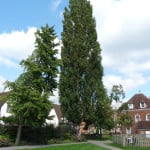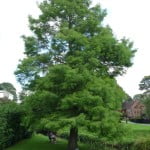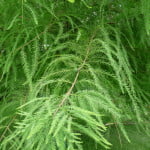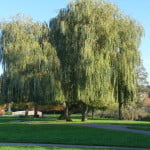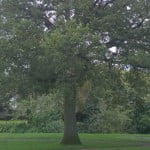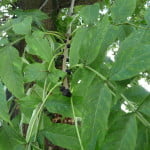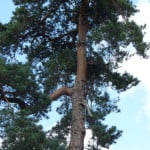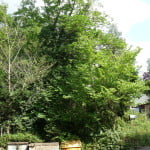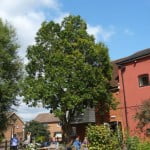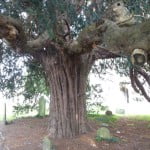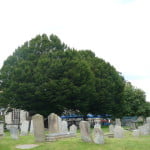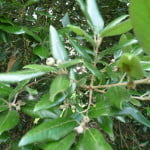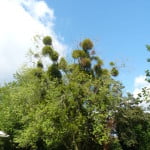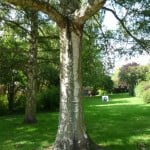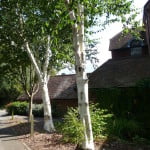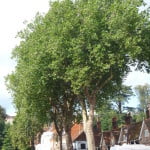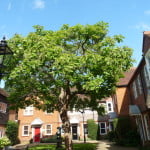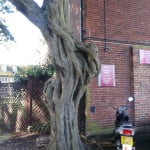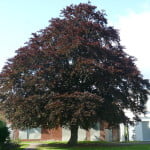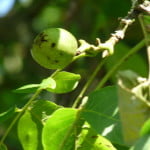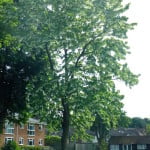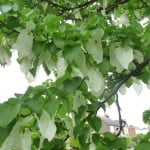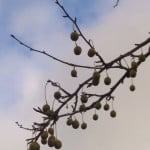A self guided circular tree trail of central Farnham by Peter Bridgeman.
Download the Map of trail
Starting in Gostrey Meadow
| 1. Lombardy Poplar (Populus nigra ‘Italica’) | |
| Introduced into Britain from Northern Italy in 1758. Often looks taller than it is due to its fastigiate or upright form. Can grow to 40m. This is around 30m (100 ft) and is one of the tallest trees in Farnham. Like many poplars, they are comparatively short-lived. One was felled this summer due to decay. There are several other species of poplar in Farnham. | |
| 2. Maidenhair Tree (Ginkgo biloba) | |
| Introduced in 1754 from China, with the first recorded planting at Kew Gardens by Princess Augusta, mother of George III, in 1762 and it’s still there at 250 plus years old. There are specimens in China some 3000 years old. A very ancient species pre-dating the dinosaurs, with some saying they go back 150 million years. The dried leaves have many therapeutic properties and the Institute for Natural Products Research claimed can prevent bed-wetting, soothe bladder irritation, treat intestinal worms and cure gonorrhea! | |
| 3. Dawn Redwood (Metasequoia glytostroboides) | |
| This native of China was thought to be extinct until found in the Szechwan region in 1941 and first introduced to England in 1948. One of the original plantings is at Cambridge Botanic Gardens and is already over 20m tall with a wonderful fluted trunk. It is a deciduous conifer like the swamp cypress (Taxodium) and larch (Larix). This one is some 40 years old | |
|
Dawn redwood foliage |
|
| 4. Golden Weeping Willow (Salix x sepulcralis ‘Chrysocoma’) | |
| Introduced from France in the early 19 century. Frequently planted as a landscape feature near water but will grow on most soils. It’s a very thirsty tree so not suitable close to buildings on shrinkable clay soils. Probably the most recognizable of all large trees. | |
| 5. Alder (Alnus glutinosa) | |
| A native of Britain and Europe and will grow in most soils but very tolerant of wet conditions, as can be seen either side of the wooden walkway at the southern end of Frensham Little Pond where they are growing right in the boggy area. The timber was used to make clogs in northern England. The cone like seed case is quite distinctive. | |
| 6. English or Pedunculate Oak (Quercus robur) | |
| There are some 600 species of oak worldwide and there are over 180 listed in the Hillier Manual. There are many specimens of the native English oak in Farnham and the oldest are in Farnham Park where one is thought to date back 500 years. The hard and durable timber was used for ship-building and structural timbers in building construction. The only other native is the sessile oak. You will see three more oak species on this walk. | |
| 7. Golden Rain Tree or Pride of India (Koelreuteria paniculata) | |
| A medium sized tree from China and Taiwan introduced into this country in 1763. Grows up to 12m tall with attractive small yellow flowers in July/August and bladder-like, three sectioned orange/pink- coloured fruit in the autumn. | |
| 8. Ash (Fraxinus excelsior) | |
| Native of Europe and Britain, a common hedgerow tree with many forms and varieties. There are thousands of young ash along the Hogs Back and on many main roads around Farnham. Now threatened with a fungal disease Chalara. The flexible timber was used for aircraft construction during and after WW1 and now for quality tool handles, snooker cues and it makes by far the best logs for open fires and wood-burning stoves. Easily recognized by the black buds and divided (pinnate) leaves. | |
Cross Longbridge
| 9. Horse Chestnut (Aesculus hippocastanum) | |
| Native of the borders of Greece and Albania and introduced into Britain in the early 17 century. One of the most attractive large trees with its flowers in May and the kids’ favourite with the autumn conkers. In recent years this species has suffered from the double problem of a leaf minor moth on the leaves and a bacteria (Phytophthora) causing a bleeding canker on the trunks. There are two red horse Chestnuts in the pedestrian area at the Woolmead. | |
Up Longbridge to junction of Red Lion Lane
| 10. Weeping, Willow-leaved or Silver Pear (Pyrus salicifolia ‘Pendula’) | ||
| A native of the Caucasus and introduced in the late 18C. An attractive small tree suitable for very confined spaces with white flowers in spring and very small inedible pears. | ||
| 11. Scots Pine (Pinus sylvestris) | ||
| A true native of Scotland and Northern Europe but has grown naturally in the south, particularly on acid heathlands. There are thousands at Bourne Wood and Frensham Little Pond. It is also planted as a quick-growing forest tree and the trees felled to recreate the RSPB reserve at Bourne Wood were planted to be felled for timber. The wood is used for building and furniture and is durable if kept dry. Lovely orange bark in the higher crown. | ||
Bridge over the bypass
| 12. English Elm (Ulmus procera) | ||
| Native of Britain and Europe but over 20 million large trees were lost to Dutch Elm Disease in the 1970’s. These are just suckers from the original parent trees and they too will succumb to the disease once trees produce sufficient bark to attract the elm bark beetle that transmits the fungal disease. There was a wonderful avenue of elms in Farnham Park but they were lost and replaced with limes and beech. The timber is used for furniture, especially chair seats, and Ercol stored many felled tree trunks in old gravel pits as the wood will not deteriorate under water. There is a ‘National’ collection of elms in Brighton. | ||
Back to the Maltings
| 13. Upright or Cypress Oak (Quercus robur Fastigiate group). Outside the Maltings café | ||
| This is an attractive more confined upright shaped oak. Other examples of oaks in and around Farnham are a large evergreen oak to the rear of the Museum which we shall see shortly, a Turkey oak in Langham Recreation ground in The Ridgeway there is a red oak later in the tour. You can always recognize oaks as they all have acorns. | ||
St Andrew’s Parish Church
| 14. Yew (Taxus baccata) | ||
| A native conifer frequently seen in churchyards but also makes an ornamental tree and is good for hedging and topiary. One of the longest living organisms in the world, with trees in this country thought to date back 4,000 to 5,000 years. There was one in the churchyard at Selbourne thought to be 1500 years old but this fell over in 1990 and was propped up by students from Merrist Wood – but it finally fell to pieces in 2011. The foliage and fruit are toxic. Robin Hood’s long bow was made from Yew wood and the timber is used for decorative veneers. | ||
| 15. Irish Yew (Taxus baccata ‘Fastigiata’) | ||
| An upright clone first discovered in 1780 by George Willis in the gardens of Florence Court in Northern Ireland and now widely planted as an ornamental tree. Again often seen in churchyards due to its sombre appearance. There is also a golden form. | ||
| 16. Hornbeam (Carpinus betulus) | ||
| Native of Great Britain and Europe and common in hedgerows in woodlands, especially on the clay soils of Essex. Like beech it makes a good hedge and again like beech hedges holds its dead leaves though the winter. There are several forms and cultivars and these two trees are of semi-fastigiate form. You will see a good specimen of hornbeam at the entrance to the Bush Hotel car park with a sculptured-like trunk. | ||
West Street
| 17. Cedar of Lebanon (Cedrus libani). In the library gardens | ||
| A native of NW Asia and Syria and introduced into the UK in 1645. This specimen is likely to be over 250 years old. There are also large specimens at Rangers House in Farnham Park planted in the 18th century and another storm-battered old tree in the castle grounds. The large spreading branches are prone to wind and heavy snow damage and the tree here has been braced to prevent damage. You will see a blue Atlas cedar later. | ||
| 18. Evergreen or Holm Oak (Quercus ilex) | ||
| Native to the Mediterranean region but cultivated in this country since the 16C. It can grow to very large proportions but is not completely hardy up north. It is planted as shelter belts in coastal areas in the south and south-west as it is wind and salt tolerant. The bark of the cork oak (Quercus suber) is used to make the corks for wine bottles and is grown extensively in Portugal. Like the holm oak it is evergreen. The change to screw-top wine bottles has resulted in the decline in trees grown for their bark. | ||
| 19. Weeping Beech (Fagus sylvatica ‘Pendula’) Along West Street | ||
| This is a cultivar first produced in 1836 and grafted onto the normal beech rootstock. Forms a very attractive large tree but needs space to grow; this one is too confined. You shall see a purple beech later on the trail and there is also a fastigiate form called the Dawyck beech discovered at Dawyck Botanic Gardens in Scotland. The native beech is a large, common tree with lovely lime green foliage in the spring and good autumn colour, there is a group of three 18th century beech on the southern boundary of the RSPB reserve at Bourne Wood opposite the entrance to Frensham Garden Centre. | ||
| 20. Manna or Flowering Ash (Fraxinus ornus) | ||
| A medium to large tree first introduced from Southern Europe and South West Asia around 1700. Differs from the native ash by its large creamy white flowers in May and clusters of fruit seen in late summer. A sugary substance can be extracted from cutting the bark and rumour has it that this was the source of the Manna from Heaven that helped sustain the Israelites in their exodus from Egypt. Others state the manna came from the Tamarix tree, as will be seen in Potters Gate. | ||
Across to Potters Gate and on to Beavers Road
| 21. Red Oak (Quercus rubra) | ||
| A native of NE America and east Canada and introduced to the UK in 1724. A large spreading tree that will tolerate a wide range of conditions including industrial. Can grow to 30m plus. Used as a timber tree in the States but does not grow that well in Scotland. Good autumn colour. | ||
| 22. Mistletoe (Viscum album) At the entrance to UCA | ||
| A semi-parasitic plant that lives on many species of trees such as poplars, limes, rowan, birch, fruit trees and is seen here on maple. It does not usually cause much harm but in this case it is becoming too dominant and the weakened branches could break in high winds. There is much folklore and superstition associated with this plant from the pleasant Christmas custom to Druid and Norse mythology. The seeds are spread by bird droppings. Please also see a white berried rowan (Sorbus cashmiriana), a small tree with gleaming white berries introduced from Kashmir. | ||
| 23. Silver Birch (Betula pendula) | ||
| A native of Europe and the UK and a common tree in this area. Can grow quite tall but with slender and graceful branches and pendulous twigs. It is quite shallow rooting so is one of the first to suffer in drought conditions. There are many forms and cultivars including a true weeping form Betula pendula ‘Youngii’ a small tree with pendulous branches. There’s a good example in the front garden of a house at the junction of Firgrove Hill and Alfred Road. | ||
| 24. Persian Ironwood (Parrotia persica) | ||
| A small to medium sized tree with a wide spreading habit and often multi-stemmed. It has attractive peeling bark but its main feature is the magnificent autumn leaf colour turning from green to yellow though gold, brown and crimson. It is in the same family as witch hazel with small red flowers in winter. A native of Northern Persia to the Caucasus mountains and first introduced to Britain in 1841. |
Hart Car Park
Please note the trees planted in the Hart car park, a few are growing well but most are struggling due to poor or inadequate soil preparation. Compare the London planes within the car park to those within the grassed area around the perimeter.
| 25. Himalayan Birch (Betula utilis var. jacquemontii) | |
| One of the Himalayan birches with snowy white bark introduced in 1890. Grows to a medium sized tree. There are many forms and variations in bark colour. | |
Castle Street
| 26. London Plane (Platanus x hispanica) | |
| A hybrid tree (P. occidentalis x P.orientalis). Found in Spain in the mid 17th century and first recorded in the UK in 1663. It has large maple-like leaves and wonderful mottled and peeling bark. Forms huge trees 40m plus tall and one tree planted in the Bishops Palace at Ely has a trunk diameter of 3m. Tolerates urban conditions and responds well to pollarding as can be seen here. These three trees were planted to mark Queen Victoria’s Diamond Jubilee in 1897 so are about 120 years old. The timber is used for furniture and is called lacewood. | |
Across The Borough to Borelli Yard
| 27. Indian Bean Tree (Catalpa bignoniodes) | ||
| Native to North America and introduced to Britain in 1726. Grows very fast at first and soon appears quite old, this one was only planted in about 1990 so is only 25 years old. Showy large white spikes of flowers with yellow and purple marking leading to the long bean like pods that persist. A great tree for creating shade and is well suited to this location. | ||
Central Car Park
Note the Cockspur Thorn (Crataegus crus-galli) with huge thorns and the good and poor tree planting in the car park. Note the recent planting of Turkish hazel Corylus colurna) and the established box elder trees (Acer negundo) on the side nearest Victoria Road. The box elder has pinnate or divided leaves, unusual for maples.
Across South Street (on the way you will see the hornbeam at the Bush Hotel).
| 28. False Acacia (Robinia pseudoacacia) Sainsbury’s car park | ||
| Native of USA but found in this country since 1600 and now naturalised. Good display of white pea-like flowers in May/June. There is a large specimen at the top of Green lane. There are several forms and an attractive compact yellow-leaved cultivar ‘Frisia’ makes a good small garden tree but is more prone to disease. Note the dead ivy, just cut it at the base. |
Brightwells House
| 29.Purple Beech (Fagus sylvatica ‘Riversii’) | ||
| This is another variation of the beech commonly called copper or purple beech. This is a fine specimen but its future is uncertain as it is included within the Brightwells/East Street redevelopment scheme. | ||
| 30. Walnut (Juglans regia) | ||
| A slow-growing round-headed tree that has been cultivated in this country since the Roman times both for its fruit, ornament and its prized timber. The fruit in the form of nuts does not normally ripen in this country unless we have a long hot and dry summer, but you can pickle green walnuts. The timber is used for veneers on fine furniture. There’s an Atlas Cedar (Cedrus atlantica) nearby. | ||
Across to The Victoria Garden
| 31. Rowan or Mountain Ash (Sorbus aucuparia) | ||
| A small to medium sized native tree called the mountain ash as the divided leaves resemble ash and it will grow at high altitudes (even above 1000 feet in Scotland, higher than any species). There are many ancient associations with magic and witchcraft and these trees were planted around Scottish crofts to ward off evil. There are many forms and cultivars. The birds enjoy the red fruit and if you are desperate the same fruit can be used to make Rowanberry wine. | ||
| 32. Whitebeam (Sorbus aria) | ||
| The same genus as rowan but very different. The leaves are simple and greenish-grey above and almost white on the underside – hence its name. The trees here are a cultivar ‘Lutescens ‘ The whitebeam is a native of Southern England, especially on chalk downs as can be seen along the Hogs Back. A good garden tree and there are many cultivars. | ||
Back to Gostrey Meadow |
||
| 33. Paper Handkerchief Tree (Davidia involucrata) | ||
| Passed the war memorial next to the (now closed) bowling green. A medium sized tree with very conspicuous pairs of white bracts in April/May. These look like flowers but are modified leaves looking a little like a handkerchief, a small dove or are a bit spooky. A native of China first described in 1869 and introduced into this country in 1904 by one of the great plant collectors, Ernest ‘Chinese’ Wilson. | ||
|
Paper Handkerchief leaves Paper Handkerchief fruit |
Other interesting trees in Farnham slightly out of the town centre:-
Tulip Tree (Liriodendron tulipifera) There is a large specimen standing by the roadside on Farnborough Road nearly opposite the showrooms of Optiplan Kitchens.
Introduced from North America in 1688, this large tree has unique shaped leaves and tulip-like yellow/green flowers in June/July.
Douglas Fir (Pseudotsuga menziesii) Several large specimens along Frensham Road with a row on the boundary between the SE Water reservoir and Prior Court. (There is another odd tree in the grounds of the reservoir called a telephone tree, it’s a 12m tall plastic and metal telecom mast poorly disguised as a cypress tree!)
The Douglas fir is native to North West America where it was first discovered by Archibald Menzies in 1792 and introduced to GB in 1827 by David Douglas another of the great plant collectors. It can grow to over 90m (300 ft) in the States and is among the tallest trees in Britain, reaching over 60m (200 ft) in sheltered Scottish glens.
Giant Redwood or Wellingtonia (Sequoiadendron giganteum) There is a good specimen in the grounds of Farnham Castle
A native of California USA where these trees form some of the largest organisms on earth. One, the ‘General Sherman’, is some 84m tall, has a trunk diameter of 8m, weighs around 2500 tons and is estimated to be 3000 years old. Only introduced into this country in 1853 and one of the first plantings was at Stratfield Saye in 1857 to mark the death of The Duke of Wellington; hence the name but he had nothing to do with this tree. There’s one at Benmore in Scotland at 54m and another at Polecat Copse near Haslemere nearly as tall. Our one is only a pup at some 20m.
Coast Redwood (Sequoia sempervirens) There is one standing close to the road in the garden of Hamilton House just below the castle in Castle Street.
Another giant redwood tree from California and Oregon, again discovered by Archibald Menzies in 1794, introduced to Europe in 1840 and three years later into Britain. In its natural habitat it will grow to 100m-plus and is a contender for the tallest tree in the world, but the gum trees (Eucalyptus) of Australia would challenge that.
Golden Deodar Cedar (Cedrus deodara ‘Aurea’)
Its drooping leading shoots distinguish this species and there is a fine example of the golden form in the front garden of a house at the top of Castle Street. The deodar was introduced from West Himalaya in 1831 and can grow into a very large tree.
Mulberry (Morus nigra) black (Morus alba) white
The ‘Mulberry Hotel’ near Farnham station is named after a mulberry standing in the garden. At one time they were claiming this tree to be 300 years old but in my estimation it’s less than 100. The tree was introduced in the early 16C from Asia and its leaves are the staple diet of the silkworm. It is quite a small-growing tree and can look gnarled and old when comparatively young. The tree at the Mulberry has suffered in the recent past by excavations around its rooting area.


